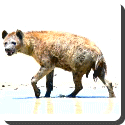 Jackal — A jackal is any of three (sometimes four) small to medium-sized members of the family Canidae, found in Africa, Asia and Southeastern Europe. Jackals fill a similar ecological niche to the coyote in North America, that of predators of small to medium-sized animals, scavengers, and omnivores. Their long legs and curved canine teeth are adapted for hunting small mammals, birds and reptiles. Big feet and fused leg bones give them a long-distance runner’s physique, capable of maintaining speeds of 16km/h (10mph) (just over 6 min/mile) for extended periods of time. They are nocturnal, most active at dawn and dusk.
Jackal — A jackal is any of three (sometimes four) small to medium-sized members of the family Canidae, found in Africa, Asia and Southeastern Europe. Jackals fill a similar ecological niche to the coyote in North America, that of predators of small to medium-sized animals, scavengers, and omnivores. Their long legs and curved canine teeth are adapted for hunting small mammals, birds and reptiles. Big feet and fused leg bones give them a long-distance runner’s physique, capable of maintaining speeds of 16km/h (10mph) (just over 6 min/mile) for extended periods of time. They are nocturnal, most active at dawn and dusk.
In jackal society the social unit is that of a monogamous pair which defends its territory from other pairs. These territories are defended by vigorously chasing intruding rivals and marking landmarks around the territory with urine and feces. The territory may be large enough to hold some young adults who stay with their parents until they establish their own territory. Jackals may occasionally assemble in small packs, for example to scavenge a carcass, but normally hunt alone or as a pair.
Jackals are considered close to what all ancestral canids looked and behaved like. Despite their outward similarity, these species are not considered closely related to one another. The Simian Jackal is actually a wolf that is thought to have taken on the appearance of a large fox or jackal through convergent evolution (by adopting a similar diet of small rodents), and the other three ‘true jackals’ are believed to have split from each other 6 mya. The Golden Jackal is thought to have evolved in Asia whilst the other two species evolved in Africa.
 Kids Portal For Parents India Kids Network
Kids Portal For Parents India Kids Network






